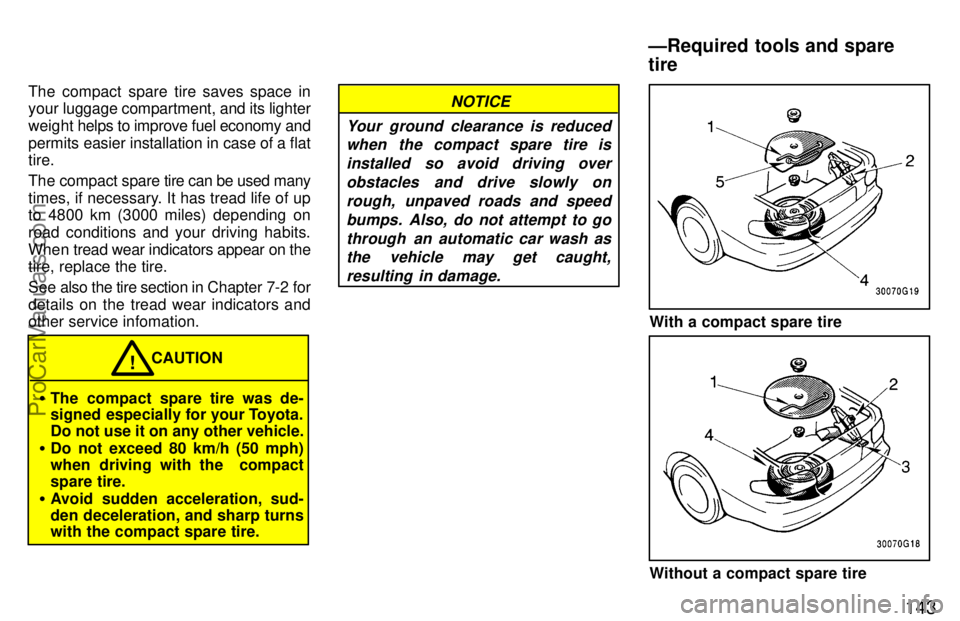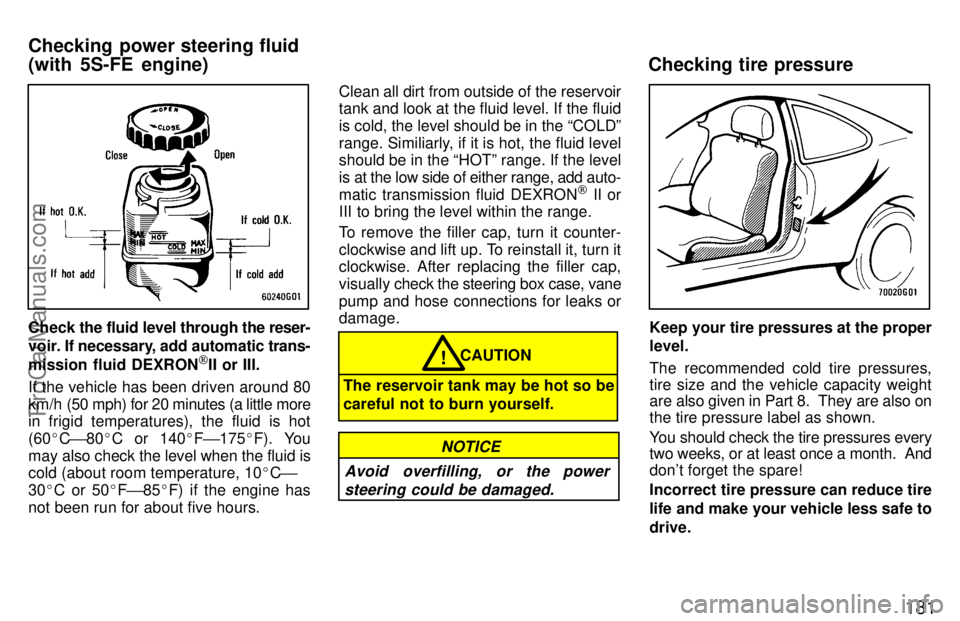Page 149 of 218

143
The compact spare tire saves space in
your luggage compartment, and its lighter
weight helps to i mprove fuel economy and
permits easier installation in case of a flat
tire.
The compact spare tire can be used many
times, if necessary. It has tread life of up
to 4800 km (3000 miles) depending on
road conditions and your driving habits.
When tread wear indicators appear on the
tire, replace the tire.
See also the tire section in Chapter 7-2 for
details on the tread wear indicators and
other service infomation.
� The compact spare tire was de-
signed especially for your Toyota.
Do not use it on any other vehicle.
� Do not exceed 80 km/h (50 mph)
when driving with the compact
spare tire.
� Avoid sudden acceleration, sud-
den deceleration, and sharp turns
with the compact spare tire. CAUTION
!
NOTICE
Your ground clearance is reduced when the compact spare tire is
installed so avoid driving overobstacles and drive slowly onrough, unpaved roads and speedbumps. Also, do not attempt to gothrough an automatic car wash asthe vehicle may get caught,
resulting in damage.
With a compact spare tire
Without a compact spare tire
ÐRequired tools and spare
tire
ProCarManuals.com
Page 187 of 218

181
Check the fluid level through the reser-
voir. If necessary, add automatic trans-
mission fluid DEXRON
[II or III.
If the vehicle has been driven around 80
km/h (50 mph) for 20 minutes (a little more
in frigid temperatures), the fluid is hot
(60 �C ' 80 �C or 140 �F ' 175 �F). You
may also check the level when the fluid is
cold (about room temperature, 10 �C '
30 �C or 50 �F ' 85 �F) if the engine has
not been run for about five hours. Clean all dirt from outside of the reservoir
tank and look at the fluid level. If the fluid
is cold, the level should be in the COLDº
range. Similiarly, if it is hot, the fluid level
should be in the HOTº range. If the level
is at the low side of either range, add auto-
matic transmission fluid DEXRON
[ II or
III to bring the level within the range.
To remove the filler cap, turn it counter-
clockwise and lift up. To reinstall it, turn it
clockwise. After replacing the filler cap,
visually check the steering box case, vane
pump and hose connections for leaks or
damage.
CAUTION
The reservoir tank may be hot so be
careful not to burn yourself.!
Avoid overfilling, or the power steering could be damaged.
NOTICE
Keep your tire pressures at the proper
level.
The recommended cold tire pressures,
tire size and the vehicle capacity weight
are also given in Part 8. They are also on
the tire pressure label as shown.
You should check the tire pressures every
two weeks, or at least once a month. And
don't forget the spare!
Incorrect tire pressure can reduce tire
life and make your vehicle less safe to
drive.
Checking power steering fluid
(with 5S-FE engine) Checking tire pressure
ProCarManuals.com
Page 188 of 218

182
Low tire pressure results in excessive
wear, poor handling, reduced fuel econo-
my, and the possibility of blowouts from
overheated tires. Also, low tire pressure
can cause poor sealing of the tread bead.
If the tire pressure is excessively low,
there is the possibility of wheel deforma-
tion and/or tire separation.
High tire pressure produces a harsh ride,
handling problems, excessive wear at the
center of the tire tread, and a greater pos-
sibility of tire damage from road hazards.
If a tire frequently needs refilling, have it
checked by your Toyota dealer.
The following instructions for check-
ing tire pressure should be observed:
� The pressure should be checked
only when the tires are cold. If your
vehicle has been parked for at least 3
hours and has not been driven for
more than 1.5 km or 1 mile since, you
will get an accurate cold tire pressure
reading.
� Always use a tire pressure gauge.
The appearance of a tire can be mis-
leading. Besides, tire pressure that
are even just a few pounds off can de-
grade handling and ride. �
Take special care when adding air
to the compact spare tire. The
smaller tire size can gain pressure
very quickly. Add compressed air in
small quantities and check the pres-
sure often until it reaches the specified
pressure.
� Do not bleed or reduce tire pres-
sure after driving. It is normal for the
tire pressure to be higher after driving.
� Never exceed the vehicle capacity
weight. The passenger and luggage
weight should be located so that the
vehicle is balanced.
� Be sure to reinstall the tire inflation
valve caps. Without the valve caps,
dirt or moisture could get into the valve
core and cause air leakage. If the caps
have been lost, have new ones put on
as soon as possible.
CHECKING YOUR TIRES
Check the tire tread for the tread wear
indicators. If the indicators show, re-
place the tires.
The tires on your Toyota have built-in
tread wear indicators to help you know
when the tires need replacement. When
the tread depth wears to 1.6 mm (0.06 in.)
or less, the indicators will appear. If you
can see the indicators in two or more adja-
cent grooves, the tire should be replaced.
The lower the tread, the higher the risk of
skidding.
The effectiveness of snow tires is lost
if the tread wears down below 4 mm
(0.16 in.).
Checking and replacing tires
ProCarManuals.com
Page 192 of 218
186
�After driving your vehicle the first 1600
km (1000 miles), check that the wheel
nuts are tight.
� If you have rotated, repaired, or
changed your tires, check that the
wheel nuts are still tight after driving
1600 km (1000 miles).
� When using tire chains, be careful not
to damage the aluminum wheels.
� Use only the Toyota wheel nuts and
wrench designed for your aluminum
wheels.
� When balancing your wheels, use only
Toyota balance weights or equivalent
and a plastic or rubber hammer.
� As with any wheel, periodically check
your aluminum wheels for damage. If
damaged, replace immediately.
Aluminum wheel precautions
ProCarManuals.com
Page 209 of 218
Part 8
203
SPECIFICATIONS
�Dimensions and weight
� Engine
� Fuel
� Service specifications
� Tires
� Fuses
ProCarManuals.com
Page 210 of 218
204
Overall lengthmm (in.)
Overall width mm (in.)
Overall height mm (in.)
Wheelbase mm (in.)
Front tread mm (in.)
Rear tread mm (in.)
Vehicle capacity weight
(occupants + luggage) kg (lb.) 4495 (177.0)
1750 (68.9) 1310 (51.6)
*1
2540 (100.0)
1515 (59.6)
1495 (58.9)
329 (725) 4425 (174.2)
1750 (68.9)
1305 (51.4)
*1
2540 (100.0)
1515 (59.6)
1495 (58.9)
329 (725) 4495 (177.0)
1750 (68.9)
1325 (52.2)
*1
2540 (100.0)
1515 (59.6)
1495 (58.9)
329 (725)
Coupe LiftbackConvertible
*1: Unladen vehicle
Dimensions and weight
ProCarManuals.com